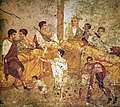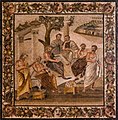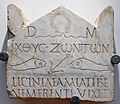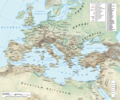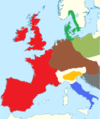The Ancient Rome portal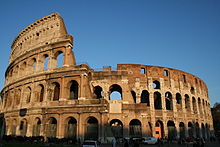  In modern historiography, ancient Rome is the Roman civilisation from the founding of the Italian city of Rome in the 8th century BC to the collapse of the Western Roman Empire in the 5th century AD. It encompasses the Roman Kingdom (753–509 BC), the Roman Republic (509–27 BC), and the Roman Empire (27 BC–476 AD) until the fall of the western empire. Ancient Rome began as an Italic settlement, traditionally dated to 753 BC, beside the River Tiber in the Italian Peninsula. The settlement grew into the city and polity of Rome, and came to control its neighbours through a combination of treaties and military strength. It eventually controlled the Italian Peninsula, assimilating the Greek culture of southern Italy ( Magna Grecia) and the Etruscan culture, and then became the dominant power in the Mediterranean region and parts of Europe. At its height it controlled the North African coast, Egypt, Southern Europe, and most of Western Europe, the Balkans, Crimea, and much of the Middle East, including Anatolia, Levant, and parts of Mesopotamia and Arabia. That empire was among the largest empires in the ancient world, covering around 5 million square kilometres (1.9 million square miles) in AD 117, with an estimated 50 to 90 million inhabitants, roughly 20% of the world's population at the time. The Roman state evolved from an elective monarchy to a classical republic and then to an increasingly autocratic military dictatorship during the Empire. Ancient Rome is often grouped into classical antiquity together with ancient Greece, and their similar cultures and societies are known as the Greco-Roman world. Ancient Roman civilisation has contributed to modern language, religion, society, technology, law, politics, government, warfare, art, literature, architecture, and engineering. Rome professionalised and expanded its military and created a system of government called res publica, the inspiration for modern republics such as the United States and France. It achieved impressive technological and architectural feats, such as the empire-wide construction of aqueducts and roads, as well as more grandiose monuments and facilities. ( Full article...) Selected article -
General imagesThe following are images from various ancient Rome-related articles on Wikipedia.
Selected biography -Nero Claudius Caesar Augustus Germanicus ( /ˈnɪəroʊ/ NEER-oh; born Lucius Domitius Ahenobarbus; 15 December AD 37 – 9 June AD 68) was a Roman emperor and the final emperor of the Julio-Claudian dynasty, reigning from AD 54 until his death in AD 68. Nero was born at Antium in AD 37, the son of Gnaeus Domitius Ahenobarbus and Agrippina the Younger (great-granddaughter of the emperor Augustus). Nero was three when his father died. By the time Nero turned eleven, his mother married Emperor Claudius, who then adopted Nero as his heir. Upon Claudius' death in AD 54, Nero ascended to the throne with the backing of the Praetorian Guard and the Senate. In the early years of his reign, Nero was advised and guided by his mother Agrippina, his tutor Seneca the Younger, and his praetorian prefect Sextus Afranius Burrus, but sought to rule independently and rid himself of restraining influences. The power struggle between Nero and his mother reached its climax when he orchestrated her murder. Roman sources also implicate Nero in the deaths of both his wife Claudia Octavia – supposedly so he could marry Poppaea Sabina – and his stepbrother Britannicus. ( Full article...)Did you know?
Related portalsTopicsCategoriesList articlesSelected picture
WikiProjectsThe following WikiProjects are related to Ancient Rome:
Things you can do
Quotes
Associated WikimediaThe following Wikimedia Foundation sister projects provide more on this subject:
Web resources
| |||||||||||||||||||||||||||
The Ancient Rome portal  In modern historiography, ancient Rome is the Roman civilisation from the founding of the Italian city of Rome in the 8th century BC to the collapse of the Western Roman Empire in the 5th century AD. It encompasses the Roman Kingdom (753–509 BC), the Roman Republic (509–27 BC), and the Roman Empire (27 BC–476 AD) until the fall of the western empire. Ancient Rome began as an Italic settlement, traditionally dated to 753 BC, beside the River Tiber in the Italian Peninsula. The settlement grew into the city and polity of Rome, and came to control its neighbours through a combination of treaties and military strength. It eventually controlled the Italian Peninsula, assimilating the Greek culture of southern Italy ( Magna Grecia) and the Etruscan culture, and then became the dominant power in the Mediterranean region and parts of Europe. At its height it controlled the North African coast, Egypt, Southern Europe, and most of Western Europe, the Balkans, Crimea, and much of the Middle East, including Anatolia, Levant, and parts of Mesopotamia and Arabia. That empire was among the largest empires in the ancient world, covering around 5 million square kilometres (1.9 million square miles) in AD 117, with an estimated 50 to 90 million inhabitants, roughly 20% of the world's population at the time. The Roman state evolved from an elective monarchy to a classical republic and then to an increasingly autocratic military dictatorship during the Empire. Ancient Rome is often grouped into classical antiquity together with ancient Greece, and their similar cultures and societies are known as the Greco-Roman world. Ancient Roman civilisation has contributed to modern language, religion, society, technology, law, politics, government, warfare, art, literature, architecture, and engineering. Rome professionalised and expanded its military and created a system of government called res publica, the inspiration for modern republics such as the United States and France. It achieved impressive technological and architectural feats, such as the empire-wide construction of aqueducts and roads, as well as more grandiose monuments and facilities. ( Full article...) Selected article -
General imagesThe following are images from various ancient Rome-related articles on Wikipedia.
Selected biography -Nero Claudius Caesar Augustus Germanicus ( /ˈnɪəroʊ/ NEER-oh; born Lucius Domitius Ahenobarbus; 15 December AD 37 – 9 June AD 68) was a Roman emperor and the final emperor of the Julio-Claudian dynasty, reigning from AD 54 until his death in AD 68. Nero was born at Antium in AD 37, the son of Gnaeus Domitius Ahenobarbus and Agrippina the Younger (great-granddaughter of the emperor Augustus). Nero was three when his father died. By the time Nero turned eleven, his mother married Emperor Claudius, who then adopted Nero as his heir. Upon Claudius' death in AD 54, Nero ascended to the throne with the backing of the Praetorian Guard and the Senate. In the early years of his reign, Nero was advised and guided by his mother Agrippina, his tutor Seneca the Younger, and his praetorian prefect Sextus Afranius Burrus, but sought to rule independently and rid himself of restraining influences. The power struggle between Nero and his mother reached its climax when he orchestrated her murder. Roman sources also implicate Nero in the deaths of both his wife Claudia Octavia – supposedly so he could marry Poppaea Sabina – and his stepbrother Britannicus. ( Full article...)Did you know?
Related portalsTopicsCategoriesList articlesSelected picture
WikiProjectsThe following WikiProjects are related to Ancient Rome:
Things you can do
Quotes
Associated WikimediaThe following Wikimedia Foundation sister projects provide more on this subject:
Web resources
| |||||||||||||||||||||||||||



